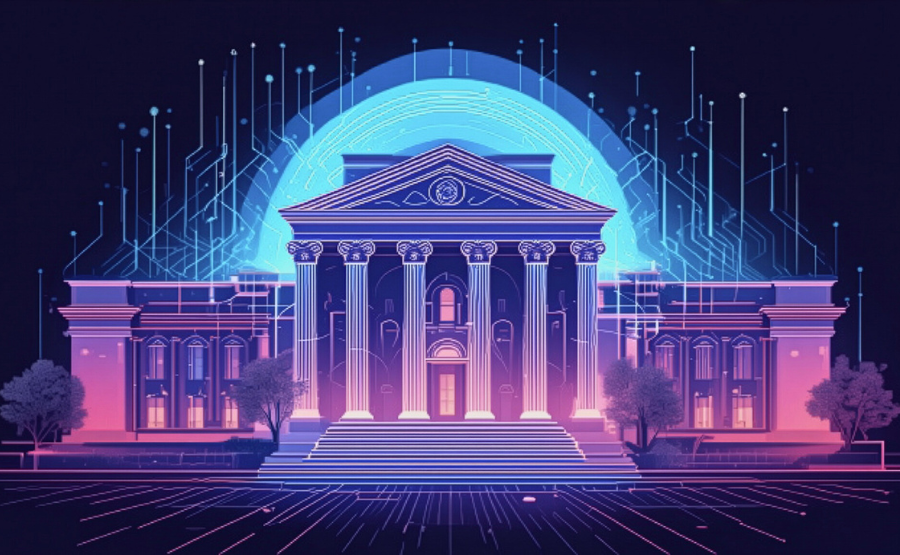When Maneka reached out to share her article, I was genuinely interested in understanding her stance on AI and data’s transformative potential in higher education. It’s been years since I’ve graduated from college and these tools were not available back then. The context that higher education is facing today -declining enrollment and rising student expectations to name a few- pushes universities to embrace new approaches as they think about their curriculums, attractiveness but also about preparing their fellows students to today’s professional world.
This paper, authored by one of our talented Junior Consultants, outlines a strategic framework centered on Enrollment & Recruitment, Academic & Teaching Innovation, and Student Success & Experience. It highlights the necessity of shifting to data and AI-driven models for a student-centric future. It emphasizes that success depends on fostering a culture of data governance, collaboration, and continuous learning and recommends that institutions leverage their data assets and adopt innovative technologies to build more efficient, resilient and sustainable future. Just like other businesses, organizations and institutions, we at Artefact are committed to helping institutions achieve these goals. Enjoy the reading!
Ghadi Hobeika, Managing Partner & Artefact US CEO
Executive Summary
Higher education in the United States is at a critical turning point. Faced with mounting pressures – including declining enrollment, constrained budgets, and rising student expectations – colleges and universities must rethink how they operate, engage, and support their communities.
This paper explores how data and AI can serve as powerful enablers of that transformation.
It introduces a strategic framework centered on three key levers:
- Enrollment & Recruitment,
- Academic & Teaching Innovation,
- and Student Success & Experience,
supported by foundational enablers like Operational Efficiency and Data Governance. Through real-world examples, we highlight how Artefact has helped institutions boost student retention, reduce dropout rates, and streamline costs using tools like predictive analytics, AI-driven personalization, and integrated data platforms.
The paper also acknowledges that the path to impact isn’t purely technological – successful implementation requires strong data governance, continuous learning, and cross-campus collaboration. With its education-focused teams, ethical AI commitment, and proven ability to drive measurable outcomes, Artefact stands ready to help higher education institutions build smarter, more resilient futures.
- Transformation is a strategic necessity, not just an option: Higher education is at a breaking point due to budget constraints, demographic shifts, and rising student expectations. To survive, institutions must shift from outdated, intuitive methods to a data and AI-driven approach.
- AI and data enable a student-centric future.They allow for smarter enrollment, personalized learning, and a better student experience, moving institutions from a reactive to a proactive model.
- Success depends on culture, not just technology. Simply buying new tech isn’t enough. Lasting transformation requires strong data governance, cross-campus collaboration, and a culture of continuous learning to truly unlock the potential of AI.
Higher Education’s Current Landscape
Higher education has long been a cornerstone of America’s economic strength, innovation, and global competitiveness. However, the sector is now under mounting pressure from multiple directions.
Many institutions face tightening budgets and intensifying scrutiny around the value of a college degree, all while trying to keep up with rapidly rising student expectations for personalized, flexible, and technology-enabled learning experiences. The looming “enrollment cliff” – with undergraduate enrollment projected to decline by over 575,000 students (15%) between 2025 and 20291 – only compounds these challenges.
Internally, higher education institutions (HEIs) struggle with fragmented and siloed data systems, outdated administrative processes, and limited ability to personalize learning at scale. This hampers their ability to proactively meet evolving student needs. Despite the vast amounts of data they collect, many colleges and universities continue to rely on intuition, historical precedent, or anecdotal evidence rather than leveraging robust analytics – essentially defaulting to “gut feel” or intuition over data-driven decision-making.
Is this a Breaking Point for Higher Education?
Facing pressures from demographic shifts, tight budgets, and student demand for personalized experiences, HEI must transform. While statistics prove this need, the daily reality on campus shows that institutions need to rethink how they operate and support students.
“We get hundreds of inquiries a day. There’s no centralized view and the information is highly unorganized, so we end up pasting questions into group chats. It’s overwhelming, and it’s hard to give prospective students the quick, clear answers they deserve.”
“Students expect the same seamless experience they get from Amazon or Netflix. Meanwhile, we’re still asking them to call three different offices to get answers.”
– Admissions staff, Large private university
“Our faculty are incredible educators, but they’re spending so much time digging through different systems, files, and folders just to understand how their students are doing. We need a simpler way to see the whole picture.”
– Professor, Large public university
These stories are not isolated. They reflect a broader reality across campuses everywhere: institutions are grappling with fragmented systems, overwhelmed staff, and students whose expectations have rapidly outpaced traditional processes.
By harnessing the power of AI and data, universities have the opportunity to fundamentally rethink how they attract, support, and graduate students, building more agile, student-centered, and resilient institutions for the future.
Key Levers for Higher Education Transformation
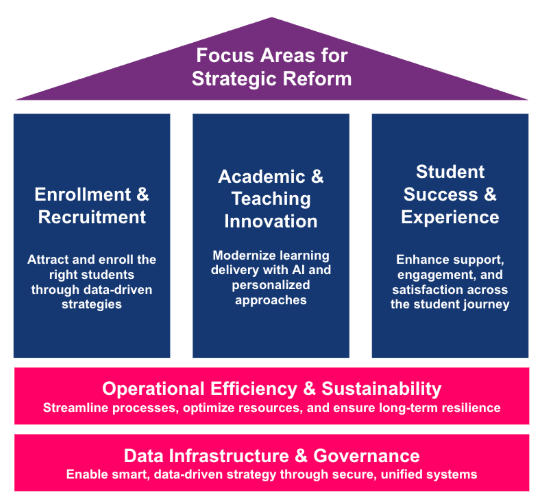
This framework outlines the key levers for strategic reform in higher education, centered on three core pillars:
- Enrollment & Recruitment,
- Academic & Teaching Innovation,
- and Student Success & Experience.
These focus areas aim to help institutions attract the right students, modernize learning delivery, and enhance the overall student journey.
Supporting these pillars are critical enablers – Operational Efficiency & Sustainability and Data Infrastructure & Governance – which provide the foundation to streamline processes, reduce costs, and harness secure, integrated data for smarter decision-making.
However, the path to transformation is not without complexity. Effective integration of AI and data solutions requires more than just technology, it demands robust data governance, clear accountability, and a culture of continuous learning and adaptation. Institutions must invest in change management, cross-functional collaboration, and upskilling to realize the full potential of these innovations.
How Artefact can help Higher Education Institutes
At Artefact, we see three critical ways data and AI can transform higher education. These areas of impact align directly with the strategic levers outlined above, from attracting and retaining students to modernizing teaching and improving operational resilience.
Across each, we bring targeted solutions, from predictive analytics to AI-powered learning and secure data ecosystems, alongside a proven track record of driving measurable outcomes.
1. Unlocking enrollment growth and alumni engagement with predictive analytics and unified data
With intensifying competition and shifting demographics, universities must rethink how they recruit, engage, and retain students, while also strengthening alumni relationships for long-term support. Artefact enables this through Customer Data Platforms (CDPs) that unify admissions, student services, and alumni data; AI-driven personalization for outreach and engagement campaigns and predictive enrollment models that forecast trends.
At a large public American university, Artefact deployed a CDP integrated with advanced predictive analytics to break down data silos and create targeted engagement. This boosted student enrolments, drove a 15% rise in student retention and a 25% increase in alumni engagement, while streamlining administrative processes enough to deliver over $500,000 in annual savings. Beyond admissions, these platforms are also enabling smarter fundraising campaigns and donor strategies.
2. Personalizing learning through AI to boost student success and retention
Many institutions struggle to tailor academic support and engagement at scale, which leads to disengagement, skills gaps, and higher dropout rates. Artefact helps universities deploy AI-driven personalized learning platforms, adaptive tutoring systems, early alert models to identify at-risk students, and data-driven career pathways that align with market needs.
For example, at a private STEM-focused college, Artefact implemented an AI-powered learning platform that created customized pathways and real-time feedback loops, resulting in a 12% increase in student pass rates and a 10% drop in dropout rates. Our solutions also helped the institution redesign curriculum strategies to close industry skill gaps and ensure graduates are truly job-ready.
3. Driving operational efficiency and sustainable resource management
Amid budget constraints, universities must maximize how they use faculty, facilities, and funds – while also advancing sustainability goals. We build data-driven models to optimize staffing and space, dashboards to track energy and water use, predictive maintenance tools to prevent costly repairs, and robust financial forecasting frameworks.
Our team worked with a mid-sized liberal arts institute to develop a comprehensive resource optimization model, leading to a 15% reduction in administrative costs and a 5% decrease in campus energy use. This not only supported their financial resilience but also advanced campus-wide sustainability commitments.
Conclusion
Higher education is at a pivotal moment. By thoughtfully embracing data and AI, institutions can break down silos, personalize learning and support, and build more efficient, resilient universities. The opportunities to drive student success, optimize resources, and secure long-term sustainability have never been clearer. Those that act decisively now, leveraging their data assets and adopting innovative technologies, will be best positioned to fulfill their educational mission and thrive in an increasingly competitive landscape.
Contact Artefact today to explore how we can help you build an agile, data-driven university and achieve meaningful, measurable outcomes.
 BLOG
BLOG